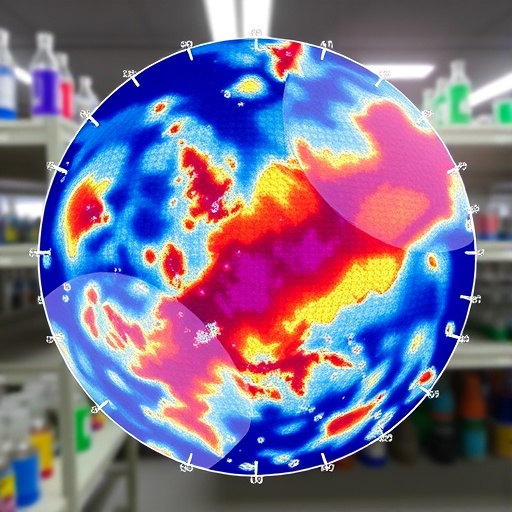In a groundbreaking study that sheds new light on the complex behavior of polyoxometalates (POMs), chemists at the University of Vienna have unveiled a comprehensive roadmap for understanding the stability and transformations of these intricate molecular cages in aqueous environments. Polyoxometalates, nanoscopic assemblies composed of metal and oxygen atoms arranged in highly ordered frameworks, have long been prized for their versatility in catalysis, energy storage, and medical applications. However, their utility has been marred by an elusive unpredictability when dissolved in liquid media — often exhibiting alterations and decomposition that have confounded reproducibility and consistency in experimental outcomes.
This recent investigation, spearheaded by Ingrid Gregorovic, Nadiia I. Gumerova, and Annette Rompel, delves deeply into the physicochemical dynamics of POMs, specifically focusing on Keplerate-type structures. These are spherical molecular constructs characterized by geometries reminiscent of geodesic domes found in nature, comprising dozens of interconnected metal-oxygen units measuring mere nanometers in diameter. Historically valued as idealized models for studying molecular recognition and catalysis, Keplerates’ perceived robustness belies a hidden susceptibility to environmental variables, which this study now quantifies with unprecedented precision.
Through exhaustive experimental scrutiny, the University of Vienna team systematically examined how Keplerate POMs fare under a suite of conditions encompassing diverse pH ranges, temperatures, and buffer systems typical in laboratory settings. Their results decisively demonstrate that these molecular mandalas maintain their architectural integrity predominantly in strongly acidic media. Conversely, as the pH approaches neutrality—a common scenario in biological and environmental contexts—the cages undergo rapid rearrangements. They fragment into smaller units, consequently altering their chemical identity and functional properties. Such transformations underscore a critical pitfall: previous studies may have inadvertently characterized breakdown products instead of the intact POMs, potentially skewing interpretations in catalysis and biomedicine.
One notable finding pertains to the metal constituents themselves. The study establishes a marked difference in stability between tungsten-based and molybdenum-based Keplerates, with the former exhibiting a pronounced resilience to near-neutral conditions. This insight is not merely academic; it offers a pragmatic guideline for researchers aiming to tailor their experiments for reliable results. Selecting tungsten-derived POMs when working in biologically relevant media, for example, could circumvent issues stemming from premature molecular disintegration.
Beyond characterizing these stability profiles, the researchers have constructed an expansive “Speciation Atlas” that serves as a practical compendium for scientists engaged in POM research. This atlas compiles empirical data sets conjoined with straightforward stability assays and definitive recommendations regarding optimal experimental conditions. By disseminating this atlas openly, the team aspires to create a foundation for more reproducible, efficient studies across disciplines ranging from materials science to medicinal chemistry. The atlas goes beyond dictating mere ‘stable’ or ‘unstable’ categorization; it equips users with nuanced understanding to strategize experiment design and accelerate the translation of ideas into tangible, reliable results.
While the structural beauty of these polyoxometalate cages may evoke images of perfect symmetry, their dynamic nature revealed by this study underscores the complexity inherent in molecular systems. Environmental sensitivity and speciation dynamics emerge as critical factors that must be acknowledged to harness their full potential. Indeed, the apparent simplicity of a POM’s geometric elegance contrasts starkly with the chemical fragility observed when exposed to real-world laboratory conditions.
The implications of these insights ripple through numerous fields. In catalysis, where POMs act as synthetic analogues of enzymatic active sites, ensuring molecular fidelity during reactions is vital for accurate mechanistic elucidation and catalyst optimization. Similarly, energy research initiatives that capitalize on POMs for charge storage and electron transfer processes hinge on the stability of these molecular cages in operational media. Moreover, in the burgeoning arena of POM-based biomedical applications — including drug delivery and imaging agents — the reproducibility and predictability of molecular behavior directly impact safety and efficacy profiles.
Notably, the meticulous approach by the University of Vienna team contributes toward addressing the broader reproducibility crisis in chemical research. By identifying the precise parameters influencing POM speciation, they provide a toolset that shields scientists from unintentional mischaracterization. This effort fosters transparency and rigor, ultimately bolstering confidence in reported findings and hastening scientific progress.
The study’s methodology reflects a judicious combination of analytic techniques and solution chemistry, emphasizing real-world relevance over purely theoretical constructs. By embracing complexity rather than circumventing it, the researchers advocate for a paradigm shift where molecular cages are contextualized within their operative milieus, rather than studied in isolation. This holistic perspective is crucial for next-generation applications where molecular stability underpins functional longevity.
In sum, this extensive work delineates a clear frontier in polyoxometalate science. It elevates the understanding of molecular cage behavior from assumption to actionable knowledge, fostering consistency and innovation. The universal availability of the Speciation Atlas stands as a testament to open science principles and sets a benchmark for how complex chemical systems should be characterized and utilized moving forward.
As the scientific community digests these findings, it is expected that the roadmap authored by Gregorovic, Gumerova, and Rompel will become an indispensable reference for chemists, materials scientists, and biomedical engineers alike. Their contributions herald a new era where the enigmatic beauty of molecular mandalas aligns with concrete experimental rigor, unlocking potentials previously hindered by unpredictability.
Subject of Research: Stability and speciation behavior of polyoxometalate molecular cages (Keplerates) in aqueous solution.
Article Title: Speciation atlas of polyoxometalates in aqueous solution (Part II): Molybdenum browns
News Publication Date: 31-Oct-2025
Web References:
DOI: 10.1126/sciadv.aea1910
Image Credits: Universität Wien / Rompel Lab
Keywords
Polyoxometalates, molecular cages, Keplerates, stability, aqueous solution, speciation atlas, tungsten, molybdenum, catalysis, energy storage, biomedical applications, open data, reproducibility




